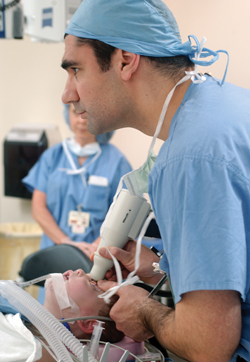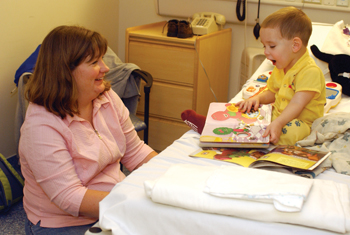
Franco Recchia, M.D., uses the RetCam to take pictures of Dylan Cansler's retinas.
Photo by Dana Johnson
Device eases eye exams in children

Dylan Cansler, 2, and his mother Jennifer, play in the holding room before he gets his eyes examined with the new RetCam.
Photo by Dana Johnson
A state-of-the-art camera donated to the Department of Ophthalmology and the Tennessee Lions Eye Center at the Monroe Carell Jr. Children's Hospital at Vanderbilt has changed how Vanderbilt experts can track eye problems in children.
Last September, the Lions Club of Tennessee donated the RetCam II to the hospital because infants and children can be very difficult to accurately screen for disorders of the retina.
The retina is the delicate tissue composed of nerves and blood vessels that line the inside of the back of the eye. Thousands of children worldwide lose vision permanently because of diseases and injuries of the retina.
“We decided to ask members across the state to help us raise the money and they quickly agreed,” said Ed Lindsey, president of Tennessee Lions Charities in Lawrenceburg, Tenn.
“We are committed to this program of trying to discover potential eye problems in very young children. We're willing to do whatever it takes. We understood this particular device was vital.”
The RetCam is a specialized digital camera attached to a portable computer system.
It makes examinations much easier and more accurate in a couple of ways: first, the cameras that are traditionally used to take a clear image of the retina require the patient to be awake, sit upright and not blink while an image of the back of the eye is captured. That's a tall order for infants and small children, so doctors have to rely on quick examination skills or other evidence to make a diagnosis.
Second, the design of the unit is more suitable to working with children.
“And the lenses of our traditional camera have a 35- to 50-degree field of view, which only catches about 10 percent of the back of the eye, so we have to take several images with the patient looking up, down, and to the side to be able to image more of the retina,” said Franco Recchia, M.D., retina specialist with the Lions Eye Center at Children's Hospital.
“RetCam has a much wider field of vision, 100 to 120 degrees, capturing closer to 90 percent of the back of the eye. Also, it's a portable unit, where other units are tied to computers in the eye exam room. The RetCam can be wheeled into an O.R., the NICU or a procedure room.”
The RetCam certainly was vital for Dylan Cansler, a Crofton, Ky., toddler referred to Vanderbilt a year-and-a-half ago.
“We noticed his eyes were crossing, his right eye especially began shaking, or twitching,” said Dylan's mother, Jennifer.
Dylan's father, Chris, said the couple's local doctor thought both of Dylan's retinas had completely detached and immediately sent the boy to the Tennessee Lions Eye Center at Vanderbilt Children's Hospital.
“By the time we saw him, his eye disease was very advanced,” said Recchia.
Dylan has congenital retinoschisis, a condition where there is a separation in any one of the 10 or so layers that make up the tissue of the retina.
“In Dylan's case, the layers were split and filled with so much fluid that his retina appeared to have ballooned out, almost to the point of reaching the front of the eye,” said Recchia.
By 8 months of age, Dylan was essentially blind and doctors would have to work fast to restore any vision at all. The boy was referred to Royal Oak, Mich., home of the only center in the country that focuses on retinoschisis. He underwent retinal surgery to tack down the layers of the retina so they would once again lie across the back of his eye. Photographs taken with a RetCam by his surgeons there documented the appearance of his retinas before and immediately after surgery. But follow-ups were difficult once Dylan got back to Tennessee.
“It was made much easier once we got RetCam in the fall,” Recchia said. “I end up using a RetCam to image children like Dylan at least twice a week in the Children's Hospital operating rooms.
“At a young age, if a clear image of the retina is crucial, we have to use anesthesia so the child sleeps while we examine him and take the image. In Dylan's case, we are able to examine with precision how he has responded to surgery and how he is developing.”
“We are so pleased with the results,” Jennifer Cansler said. “His right eye was the worst, it was almost completely gone, and he's already got some vision back. He just got re-checked at the Lions Eye Center and his vision is 20/400.”













